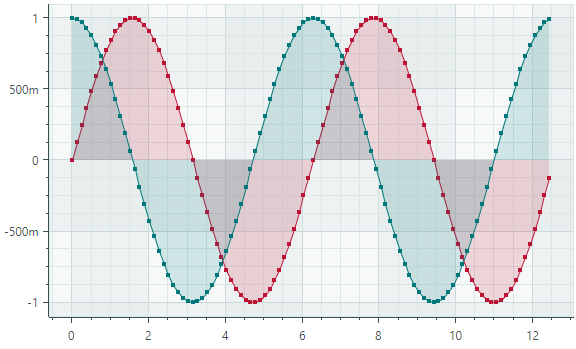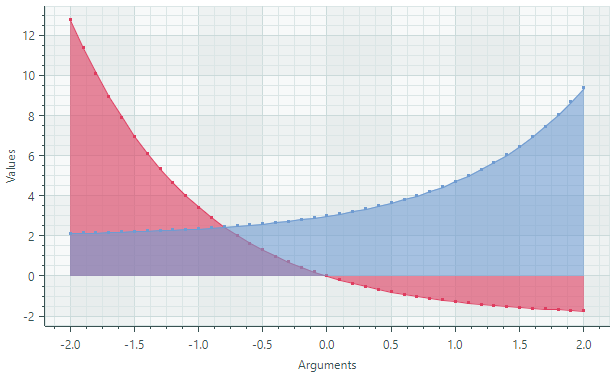Area Series View¶
The Area Series View (CartesianAreaSeriesView) connects points with lines and fills the areas between the charts and the X axis with specified colors. You can fill these areas with semi-transparent colors to blend the colors of multiple series, and keep the chart's grid lines visible underneath.

Create an Area Series View¶
To create an Area Series View, add a CartesianSeries object to the CartesianChart.Series collection, and initialize the CartesianSeries.View property with a CartesianAreaSeriesView object.
Use the CartesianSeries.DataAdapter property to supply data for the series.
The following code shows how to create an Area Series View in XAML and code-behind.
xmlns:mxc="https://schemas.eremexcontrols.net/avalonia/charts"
<mxc:CartesianChart x:Name="chartControl">
<mxc:CartesianChart.Series>
<mxc:CartesianSeries Name="areaSeries1" DataAdapter="{Binding DataAdapter}" >
<mxc:CartesianAreaSeriesView Color="Green" Transparency="0.3" MarkerSize="5" ShowMarkers="True"/>
</mxc:CartesianSeries>
</mxc:CartesianChart.Series>
</mxc:CartesianChart>
using Eremex.AvaloniaUI.Charts;
CartesianSeries series = new CartesianSeries();
chartControl.Series.Add(series);
double[] args = new double[] { 1,2,3,4,5,6,7 };
double[] values = new double[] { 5,4,3,2,3,4,5 };
series.DataAdapter = new SortedNumericDataAdapter(args, values);
series.View = new CartesianAreaSeriesView()
{
Color = Avalonia.Media.Colors.Green,
Transparency = 0.3,
ShowMarkers = true,
MarkerSize = 5
};
Tip
If you use date-time arguments, you may also need to initialize the X axis, and customize the axis scale options. Refer to the following topic for more details: Axis Scale.
Example - Create Two Area Series Views¶
The following example creates a CartesianChart control with two Area Series Views. Data for the Series Views is provided by FormulaDataAdapter objects, which calculate values according to specified formulas. It is implied that a MainWindowViewModel object is set as a data context for the window.
The created Series Views use semi-transparent red and blue colors. When the filled areas overlap, both series and grid lines remain visible.

The example demonstrates how to customize the color, fill transparency, and point markers for the Series Views.
The X and Y axes are created in XAML to perform customization of their settings. Note the use of the NumericScaleOptions.LabelFormatter property to format axis labels in a custom manner.
<mx:MxWindow xmlns="https://github.com/avaloniaui"
xmlns:x="http://schemas.microsoft.com/winfx/2006/xaml"
xmlns:vm="using:ChartAreaSeriesView.ViewModels"
xmlns:d="http://schemas.microsoft.com/expression/blend/2008"
xmlns:mc="http://schemas.openxmlformats.org/markup-compatibility/2006"
xmlns:mx="https://schemas.eremexcontrols.net/avalonia"
xmlns:mxc="https://schemas.eremexcontrols.net/avalonia/charts"
mc:Ignorable="d" d:DesignWidth="800" d:DesignHeight="450"
x:Class="ChartAreaSeriesView.Views.MainWindow"
x:DataType="vm:MainWindowViewModel"
Icon="/Assets/EMXControls.ico"
Title="ChartAreaSeriesView">
<Design.DataContext>
<vm:MainWindowViewModel/>
</Design.DataContext>
<mxc:CartesianChart x:Name="chartControl">
<mxc:CartesianChart.Series>
<mxc:CartesianSeries Name="areaSeries1" DataAdapter="{Binding AreaSeries1.DataAdapter}" >
<mxc:CartesianAreaSeriesView Color="{Binding AreaSeries1.Color}" Transparency="0.6" MarkerSize="3" ShowMarkers="True"/>
</mxc:CartesianSeries>
<mxc:CartesianSeries Name="areaSeries2" DataAdapter="{Binding AreaSeries2.DataAdapter}" >
<mxc:CartesianAreaSeriesView Color="{Binding AreaSeries2.Color}" Transparency="0.6" MarkerSize="3" ShowMarkers="True"/>
</mxc:CartesianSeries>
</mxc:CartesianChart.Series>
<mxc:CartesianChart.AxesX>
<mxc:AxisX Name="xAxis" Title="Arguments" >
<mxc:AxisX.ScaleOptions>
<mxc:NumericScaleOptions LabelFormatter="{Binding ArgsLabelFormatter}"/>
</mxc:AxisX.ScaleOptions>
</mxc:AxisX>
</mxc:CartesianChart.AxesX>
<mxc:CartesianChart.AxesY>
<mxc:AxisY Title="Values"/>
</mxc:CartesianChart.AxesY>
</mxc:CartesianChart>
</mx:MxWindow>
using Avalonia.Media;
using CommunityToolkit.Mvvm.ComponentModel;
using Eremex.AvaloniaUI.Charts;
using System;
namespace ChartAreaSeriesView.ViewModels;
public partial class MainWindowViewModel : ViewModelBase
{
static double Exp(double argument) => 2 * Math.Exp(-argument) - 2;
static double Exp2(double argument) => Math.Exp(argument) + 2;
[ObservableProperty] SeriesViewModel areaSeries1;
[ObservableProperty] SeriesViewModel areaSeries2;
[ObservableProperty] FuncLabelFormatter argsLabelFormatter = new(o => String.Format("{0:n1}", o));
const int ItemCount = 41;
const double Step = 0.1;
public MainWindowViewModel()
{
AreaSeries1 = new() { Color = Color.FromUInt32(0xffDF3C5F), DataAdapter = new FormulaDataAdapter(-2, Step, ItemCount, Exp) };
AreaSeries2 = new() { Color = Color.FromUInt32(0xff6F9BD1), DataAdapter = new FormulaDataAdapter(-2, Step, ItemCount, Exp2) };
}
}
public partial class SeriesViewModel : ObservableObject
{
[ObservableProperty] Color color;
[ObservableProperty] ISeriesDataAdapter dataAdapter;
}
Data for the Area Series View¶
You can use the following data adapters to provide data for Area Series Views:
Numeric X Values:
SortedNumericDataAdapterFormulaDataAdapter
Date and Time X Values:
SortedDateTimeDataAdapterSortedTimeSpanDataAdapter
Qualitative X Values:
QualitativeDataAdapter
Area Series View Settings¶
Color— Specifies the color used to paint the series.CrosshairMode— Specifies whether the crosshair's chart label snaps to the nearest data point, or displays an interpolated value. See Show an Exact or Interpolated Value in Crosshair Chart Labels.-
MarkerImage— Gets or sets an image to use as custom point markers. If no image is specified, default square-shaped markers are displayed. You can use anSvgImageclass instance to specify an SVG image.The
MarkerImageproperty is declared with the[Content]attribute, which allows you to define an image directly between the <CartesianAreaSeriesView> tags.<mxc:CartesianAreaSeriesView> <SvgImage Source="avares://Demo/Assets/circle.svg" /> </mxc:CartesianAreaSeriesView>SVG files contain predefined colors for SVG elements. To make these colors match your data series color, you can either:
- Manually edit the source SVG image file beforehand
- Use the
MarkerImageCssproperty to dynamically customize styles for SVG elements. The styles are applied when point markers are rendered.
-
MarkerImageCss— Specifies CSS styles for runtime customization of an SVG image defined by theMarkerImageproperty. The primary use case is replacing SVG element colors with the series color (Color). Include the{0}placeholder to insert the value of theColorproperty in the CSS code.For example, when the
MarkerImageproperty contains an SVG image with a circle element, the following CSS code styles thecirclewith an Orange fill (using the series color) and Dark Red border:<mxc:CartesianAreaSeriesView Color="orange" MarkerImageCss="circle {{fill:{0};stroke:darkred;}}"> <SvgImage Source="avares://Demo/Assets/circle.svg" /> </mxc:CartesianAreaSeriesView>See also: Example - Create a Lollipop Series View and Use Custom SVG Markers.
-
MarkerSize— Specifies the size of point markers. ShowInCrosshair— Specifies the visibility of the crosshair chart label for the current series. See Customize Chart Labels of the Crosshair.ShowMarkers— Enables or disables point markers.Thickness— Specifies the line thickness.Transparency— A value between0and1which specifies the transparency level of filled areas:0means fully opaque1means fully transparent